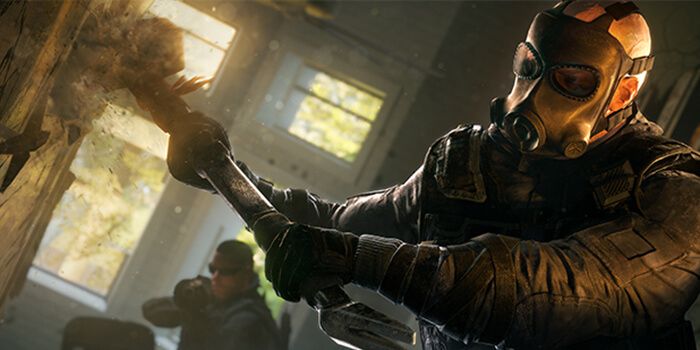Rainbow Six Siege rises out of the ashes of Rainbow 6: Patriots, which was cancelled due to the transition between last generation and current generation consoles. Instead of trying to salvage a game built on old tech, Ubisoft decided to throw out three and a half years' worth of work and start fresh, creating a title that honors the series' legacy of providing tactical, team-based shooting, while also bringing something new to the table.
Rainbow Six has always been about the squad, not the individual, and the newest installment continues this tradition, offering a variety of new multiplayer modes. Rainbow Six Siege's alpha focused a competitive team-versus-team hostage situation. Ubisoft's pre-E3 press event took a different route, unveiling Terrohunt, the game's single player/co-op mode.
Ubisoft's developers are working overtime to ensure that every Terrohunt match is unique. Terrohunt starts when players join up as a team (or, in single player, decide to plow ahead with AI-controlled allies). From there, Rainbow Six Siege puts together a unique, semi-random experience. The goal, according to developers, is to make sure that Terrohunt never delivers "the same experience twice."
Terrohunt comes with 11 maps set in different locations around the globe; each map has both day and night variants. Rainbow Six Siege selects a location randomly, then assigns one of four objectives: disarm a bomb, rescue a hostage, "classic" Terrohunt (which wasn't explained), or protect an asset. Objectives are randomly placed in the map, as are enemy soldiers and fortifications, meaning the map changes in subtle ways every time it's played.
Ubisoft's demo featured a new map, Consulate, and showed of the bomb diffusing mission type. Squads of five players (each one captained by an Ubisoft developer) sneak into the consulate, neutralize enemy soldiers, and locate two bombs hidden in the building. Once a bomb is found, the disarming period started. Essentially, players need to defend their position for a minute while the diffusing device does its work. That's not easy when enemy combatants are swarming the location, doing everything they can to disrupt the process.
Sneaking through the consulate is fine - this still is a Rainbow Six, and other than the next-gen visuals and more fluid movement, there's nothing here that really set the game apart from its predecessors. Players can send little camera-equipped robots to scout ahead, which is neat; however, only the player who deployed the robot can see the display. That leaves other players waiting, as the scouting player simply relays information over his or her headset. It's interesting, but also a little dull.
Thankfully, the action picks up when the bombs are actually getting diffused. Suddenly, the players' team has to go on the defensive; everything that used to be an obstacle is now a potential tool, and part of Rainbow Six Siege's challenge lies in taking out enemies without destroying the fortifications you'll need a little bit later.
What really makes this mode shine, however, is the game's destructible environments. Believe the hype. It's also cool. While infiltrating the consulate, players can avoid choke points by blasting holes in the wall with grenades, or smashing through them with a sledgehammer. Sometimes, finding a bomb means breaking through the floor to access a lower level, or finding a secret passage hidden in the wall. Knocking a small hole in the wall can make it easier to spot incoming enemies, leading to well-placed ambushes.
Of course, enemies can destroy the environment too, which makes defensive gameplay both thrilling and terrifying - especially given the game's "no respawns" rule. There's nothing worse than watching the clock tick down, thinking that everything's under control, only to see the back wall explode and a swarm of enemies pour through. Defending the real exits is hard enough. When new entry points appear unexpectedly? It feels impossible.
Ubisoft promises that Rainbow Six Seige's artificial intelligence is better than in any previous installment, although it's hard to get a good sense of it from only a few rounds. Enemies certainly seemed smart, and many of the matches ended in failure (even the Ubisoft developers couldn't diffuse both bombs every time). There wasn't any opportunity to try the game with friendly AI.
Still, if the rest of Rainbow Six Siege's gameplay is as tense as the bomb diffusing mode, fans are in for a treat. Many teams found themselves near death after disabling one bomb, letting out big sighs of relief.
And then they had to go deal with a second one.
Rainbow Six Siege comes out October 13, 2015 for PC, Xbox One, and PlayStation 4.

